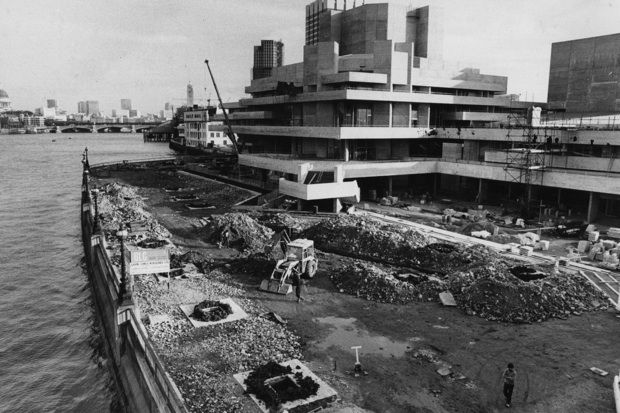The National Theatre – 50 years (and more) in The Spectator
written for the “From Our Archives” section, at The Spectator, 2 November 2013

1975: The site of the National Theatre on the South Bank, currently under construction. Designed by architect Sir Denys Lasdun. (Photo by Graham Wood/Evening Standard/Getty Images)
Today the National Theatre hosts a gala performance, screened on BBC2 at 9pm, to celebrate fifty years since its launch as a company in 1963. You can view the full programme here – I’d wanted to be cynical about a Greatest Hits parade, but reading the cast list, it simply looks astounding.
But it’s not the fiftieth birthday of Denys Lasdun’s building on the South Bank – that robotic monstrosity, suggestive of an early design for Michael Bay’s Transformers movies, if Bay’s anthropomorphic tanks could ever rear onto hind legs while made of concrete. When the building was finally complete in 1977, Auberon Waugh told The Spectator’s readers that the ‘hideous edifice’ was an apt stage for all that was ugly in modern Britain, musing like the chorus of Henry V: ‘may we cram within this concrete O the casques that did affright the air at William Tyndale Comprehensive School?’
Yet as Helen Smith recognised in a two part special on Lasdun’s architecture that same year, ‘The National Theatre is saved by the river, an enhancing foil to the expansive and dominant building, since it provides both space and movement.’ She was right – it is the National’s piazza by the river that makes it a vital London hub. Smith also reminded readers ‘Those who gasp at the horror of heated outdoor spaces must remember that this was a mid-’sixties conception, sadly out of date.’ In fact, everything about the National was out of date. It was twenty-eight years since Parliament had first voted to build it. And just shy of seventy since the campaign behind it was launched.
There isn’t space here to list all the bumps in the road in those years. But right from Granville Barker’s first public campaign meeting in 1908, The Spectator has always had the story. And reassuringly, a trawl through our archive suggests that in rooting for a National Theatre, our writers have largely been on the right side of history.
We supported state funding for high arts even in the Great Depression, devoted a page to reviving the campaign in 1935 and took the critic of The Times to task when he poo-pooed the purchase of a site for the theatre in 1937. We even kept it on the agenda during wartime – insisting that ‘when we turn to construct instead of to destroy’, theatre ‘must have a physical home’.
But the most important intervention by The Spectator was Richard Findlater’s broadside in 1960 on the government for ignoring the 1951 National Theatre Bill. Findlater, critic for The Observer, had an acrid sense of humour — with Kenneth Tynan, he’d staged a mock-funeral for the National in 1955. Findlater’s prose on the subject is delicious: it’s also the best explanation I’ve read of why the commercially successful Old Vic couldn’t become the National Theatre: ‘How can a National Theatre Company be contractually tied to one commercial television group, which insists on complete “exclusivity”?’
Eventually, Findlater won out, and the new National Theatre Company was formed to perform at the Old Vic only until its own building was completed. I wish I could quote almost everything The Spectator has published since – for starters, try Alexander Chancellor defending The Romans in Britain against the self-importance of the Greater London Council, or Hilary Spurling forgiving Peter Brook’s ‘awful’ Oedipus because: ‘this production attempts for almost the first time on any London stage to come up with the modern world.’
But I urge our readers to have as much fun as I’ve had this week – just type the details of your favourite National Theatre production into our archive search, and see what our critics thought at the time. You can share your findings in the comments – and tell us whether we got it right. I’ll also be tweeting my own favourites at @KateMaltby.






